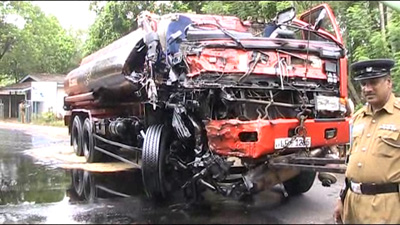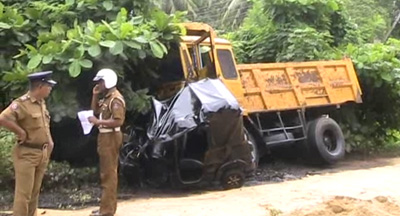Sunday Times 2
Prevent Roadkill; it could be your own
Roadkill is not a word familiar to Sri Lankans but, is well known in Australia, Canada and the United States. The reference is made in respect of animals such as kangaroo and deer killed by speeding motorists mainly by accident and in some instances, deliberately. Whichever way it happens, it is looked at with compassion and its prevention is widely publicised.

To avert roadkills, it is important to re-evaluate the existing traffic laws and lay down some important guidelines for all drivers
Unfortunately, I am forced by circumstances, to use the word ‘roadkill’ with reference to the people killed — on an average of 10 a day — on the roads of Sri Lanka. Most people are somewhat passive, like I was, when such incidents are reported in the media and, respond with the now familiar ‘Aney Pauw, Monawa Karannade, Deiwaye Heti Ohoma Thamai ‘.
However, when my own son, in the prime of his life at 23 and due to graduate early next year, was the victim of a hit and run on a pedestrian crossing by a callous motorist speeding at over 130 kmh, the incident awakened me to the stark reality of how countless mothers, fathers, their kith and kin, may also be grieving as much as we do, by the sudden death or even maiming for life, of their loved ones whom they have nurtured all their life.
My wife, who had given her heart and soul to the wellbeing of her son, from the time of conception, through infancy and childhood, seeing meticulously to his food, clothing and his educational needs, is still in a state of shock and cannot believe that she had lost her son, in an instant. How possibly can, an elder brother and two elder sisters console themselves after losing a loving brother who shared every moment of his life with them, with equal joy, every day for 23 years.
It took me a few days to get over the initial shock. Then, I tried to work out how such a thing could happen. The speed of 130 Kmh equates to over 35 metres a second. I was advised by the Police that a healthy person would normally take about eight seconds to walk from one pavement to the opposite pavement, across Duplication Road (R.A. De Mel Mawatha). This would mean, the car, an Audi, that knocked my son down, would have been over 280 metres away, when my son stepped down from the pavement to cross the road. He had one foot on the other pavement when the car hit him, throwing him 12ft above the ground, to come crashing down, bringing the three traffic lights down with him.
 The driver of the car claims that, he never saw my son’s friend who was waiting to cross, nor my son until the impact. This is confirmed by the fact that no brake marks were visible on the road before the impact and, no attempt had been made to swerve away from the pedestrian on a road almost 50 ft wide and, devoid of traffic at that time of the night.
The driver of the car claims that, he never saw my son’s friend who was waiting to cross, nor my son until the impact. This is confirmed by the fact that no brake marks were visible on the road before the impact and, no attempt had been made to swerve away from the pedestrian on a road almost 50 ft wide and, devoid of traffic at that time of the night.
The incident begs the question, whether the two people in the car were so involved with each other that, they had not seen my son crossing the road or his friend waiting to cross the road. There is no indication that the driver even glanced at the road over a distance of more than 250 metres. Why again was the car being driven at such high speed, so close to the right-hand side pavement on a 50 ft wide ‘one-way’ road devoid of traffic. Inquiries made from eyewitnesses of the incident revealed that, the driver of the Audi had attempted to flee without stopping but, as the damaged bonnet of the car had blown open, he had been forced to brake hard and stop the car. The driver and his girlfriend thereafter had callously run-away from the scene of the crime, without even waiting to see if they could help the injured, in some way.
Nothing that we say or do will bring our precious son back. However, we as the parents of our son Dimitra, his loving brother and sisters, will join with countless other parents, brothers and sisters, to raise some pertinent queries about how such incidents are handled in Sri Lanka. Almost all the parents who visited us in our time of bereavement had one nagging concern in their minds: Whether their children will return home safely from school, academy or their place of work. Some major issues and concerns that were discussed are:
a) Are the penalties imposed on callous drivers adequate enough to act as deterrent against a repetition of the crime. If a driver who has killed a person is let-off with a minor penalty, he may repeat his action time and again and, justice will in no way be served, to the first victim’s family nor the next. (This brings to mind a newspaper report I read in England sometime back, where it was stated that, Princess Anne was fined around 400 Pounds Sterling for over-speeding. When she queried, why it was so high when the normal fine for such an offence was about 40 pounds, she had been advised that it was her third offence for speeding, the first one being recorded over 35 years back with a fine of 40 pounds, the second in 1990 which carried a fine of 150 pounds and the more recent third being 400 pounds sterling for overspeeding. ‘No offence intended your Highness’. I brought up the event only to emphasise the point that in a civilized society even the Queen’s daughter is bound to uphold the Law of the land.)
Of course, the actions taken by our elite with their super cars, to uphold the traffic laws of Sri Lanka leave much to be desired.
b) Why do the authorities allow our roads and highways to be used for high-speed driving? Colombo, being the metropolis that it has become with the new developments, has heavy vehicular and pedestrian traffic most times of the day and some traffic at night. It is the undeniable right of every citizen to be able to use public roads safely at all times.
c) If the Police do not have adequate man-power to cover the major roads, a computerised system of cameras must be installed to detect high-speed driving and other traffic offences and, issue the offenders with a charge-sheet and a fine automatically. Such systems are in use in most cities of the developed world, which help to deter corrupt practices we hear so much about.
d) Another practical and useful way to limit high-speed driving, especially in the outstations is to have ‘road bumps’ with yellow stripes at pedestrian crossings with adequate street lighting. When the authorities are able to spend millions of rupees to beautify pavements, it is regrettable to note that sufficient attention is not paid to have proper pedestrian crossings with an island in the middle and adequate lighting.
e) On a ‘one way’ road such as R. A. De Mel Mawatha, which has a large number of by-lanes feeding into it, a practical way to limit the speed of motorists is to have the traffic lights flashing ‘Amber’ where there are such intersections, instead of having all the lights permanently ‘Green’ after midnight, as was the case on the day the said incident.
f) I am given to understand, where there are no signs put up to limit speed, motorists can drive at a maximum of 70 Km/hour. If the authorities do not have adequate funds to put up speed limiting signs, I am sure there will be several organisations which will volunteer to install such signs, if requested.
g) In the present scenario, without stabbing, poisoning or shooting an enemy which would result in life imprisonment when proven guilty, it would be far easier for a gangster to await an opportune moment and ‘run the enemy down’ by car and then, get away with an insignificant penalty and a suspended prison term. Are our traffic laws archaic?
It is not the intention of the writer to critique the existing traffic system or the applicable ‘road rules’. However, as most of the deaths reported involve either the three wheelers, motorcyclists or passenger transport buses, which appear to have their own set of ‘road rules’, it is important to re-evaluate the existing traffic laws and lay down some important guidelines, for all drivers of motor vehicles.
We, together with the friends of Dimitra at NIBM, NSBM and fellow old boys of Royal College, all concerned parents and well-wishers, intend to start an awareness campaign, to prevent the unwarranted ‘ROADKILL’ of innocent people from all walks of life. We will convey the message that, ‘IT COULD BE YOUR LOVED ONE WHO MAY BE THE NEXT VICTIM OF A ‘ROADKILL’, unless firm action is taken to prevent callous, careless and drunken driving.
This article is written without prejudice and in no way is intended to bring disrepute to the Police Department which is, no doubt, trying its best to curtail the current spate of accidents, with its limited resources.

